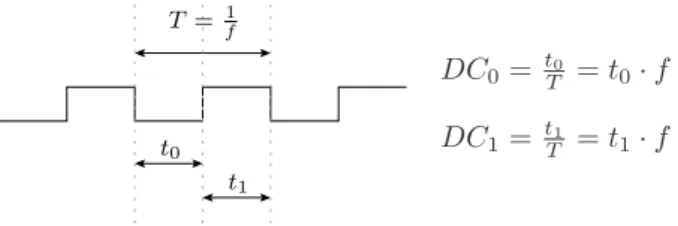Exercise 4: Fan control and temperature sensor
G. Kemnitz ∗ , TU Clausthal, Institute of Computer Science May 23, 2012
Abstract
A fan has to be controlled by a pulse width modulated (PWM) signal. From the PWM sig- nal of a temperature sensor the temperature should be determined and displayed hexadecimal in grad Celsius at the 7-segment display.
1 Pulse width modulation
In a digital signal with constant frequency f the duty cycle is the ratio between the duration of the high value and the signal period T = 1 f (figure 1).
t
0t
1T =
1fDC 0 = t T
0= t 0 · f DC 1 = t T
1= t 1 · f
Figure 1: Definition of the duty cycle
A clock signal usually has the duty cycle DC 1 = DC 0 = 50%. The duty cycle can vary continuously, so in PWM signals continuous values can be coded. First exercise is to design a circuit to control the speed of the fan at the corresponding expansion board on plug A1 via PWM.
With a large duty cycle DC 1 the fan should move fast and with a small duty cycle it should move slow. (figure 2). The value of the duty cycle should be adjustable via the switches sw1 to sw3 in eight steps.
DC 1 = 0, 75 DC 1 = 0, 25 movement
slow movement fast
Figure 2: PWM signal for fan control
2 Temperature sensor
On the expansion board is also a temperature sensor. It is behind the fan and o type SMT160.
This sensor summits the temperature PWM coded. According to the data sheet the relation between temperature and pulse width is:
DC 0 = 0, 32 + 0, 0047 · T
∗

